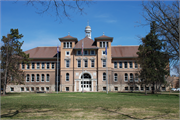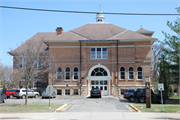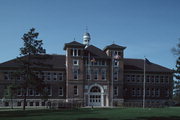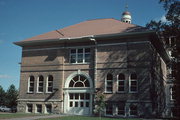| Additional Information: | A 'site file' exists for this property. It contains additional information such as correspondence, newspaper clippings, or historical information. It is a public record and may be viewed in person at the Wisconsin Historical Society, State Historic Preservation Office.
SELBY & PERKINS OF CHICAGO DESIGNED THE ORIGINAL BUILDING. CONOVER & PORTER OF MADISON DESIGNED THE FIRST ADDITION.
Stevens Point State Normal School, ancestor of today’s University of Wisconsin-Stevens Point, began as a teacher-training school and, in 1902, became one of the first schools in the country to educate young women in “domestic science” or home economics. Later, when the school was known as Central State College, it was the first in the nation to offer an environmental-conservation major.
Perkins and Selby of Chicago designed the original normal-school building as an imposing edifice notable for its fine proportions, its subtle use of textures, and its slender garlanded cupola. The building’s classical composition reflects an interpretation of the Italian Renaissance Revival style. On the symmetrical main (south) façade, a central pavilion projects beyond the plane of the two-story wings extending from either side. This pavilion stands three stories high and is flanked on either side by four-story towers. Typically, each level of a Renaissance Revival building is articulated by differences in materials and window designs. In this case, the raised foundation is of rock-faced stone, with alternating courses of thick blocks and thin slabs. The first story’s tan brick walls feature recessed courses at regular intervals, creating strongly horizontal shadow lines, whereas the upper stories appear almost completely smooth, since the mortar joints are flush with the face of the bricks. As to the fenestration, the entry arch surrounds a large fanlight, and the smaller windows on this level have round arches. By contrast, the windows on the second story are rectangular, with triangular pediments above those on the central pavillion. On the third story, fluted Ionic pilasters embrace smaller rectangular windows.
Wings and dormers at either end, added in 1901 and in 1914-15, have since been removed, so the structure looks much as it did when it was dedicated in 1894. |
|---|
| Bibliographic References: | STEVENS POINT DAILY JOURNAL: OCTOBER 28, 1893, P. 4; OCTOBER 20, 1894, P. 4; OCTOBER 24, 1894, P. 1.
STEVENS POINT GAZETTE: AUGUST 7, 1901, P. 3.
Buildings of Wisconsin manuscript. |
|---|





